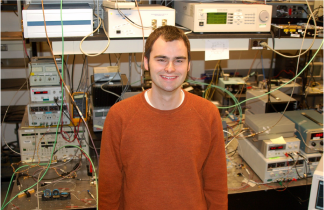Defense: Laser Interrogation for Standoff Detection of Hazardous Materials, presented the audience with a difficult problem to which the U.S. Department of Defense is allocating many resources and substantial funding:
How can you accurately detect threats from chemical, biological, radiological, nuclear, or high-yield explosives (CBRNE) from a safe stand-off distance to protect or warn those in harms way?
Laser spectroscopy is the short answer, be it UV Raman, NIR Raman, Long Wave Absorption Spectroscopy, Laser-induced Breakdown Spectroscopy (LIBS), Photoacoustice Spectroscopy, Ultrafast Spectroscopy, just to name a few. However, what kind of spectroscopy you use to identify a threat is just the beginning to making a system that can function in rugged battlefield environments and accurately deliver the information you need in the time you need it.
Panelist Scott Robertson, Research Senior Manager at Lockheed Martin, posed just how difficult this can be with some specific targets of the type of systems needed in the field. One project whose objective was to analyze threats by the vapors and residues from vehicles needed a stand-off detection distance of 400 m, an entire scan, detect and process time of 1.0 second, with a false alarm rate of only 1 in one million, and packaged in a volume of 1 cubic meter. Another specification target was to be able to scan an area of 2,700 square meters per second while searching a road 100 m wide, while traveling 60 mph.
There are other constraints as well. Tom Stark (no relation to Tony from the Iron Man series), from Landmark Technologies Joint IED Defeat Organization, reminded the audience that 99.9% of the people in an area you want to scan are not the threat. You can't and don't want to blatently scan a crowd with a potentially dangerous high-power laser system. Another constraint therefore is laser safety, particularly eye safety. Add this to the checklist of specification targets and you start bumping up against fundamental limits for power needed to detect a spectroscopic signature of a threat, as well as selectivity and sensitivity for identification of molecules.
Augustus Fountain, Senior Research Scientist in Chemistry at Edgewood Chemical Biological Center, spoke to some of these issues. Fountain spoke about choosing the wavelength/spectroscopic for your method. In the UV you gain in sensitivity but loose in selectivity. The opposite is true as you move into the IR. Another problem to consider in system design is 1/r2 loss and atmospheric attenuation. What kind of time window do you have available for scanning? Is the analyte a mixture of compounds- harder to detect spectroscopically, or something simple? Scott Roberston echoed many of these remarks. Do you want to identify the threat or do you just want to know if it is going to kill you? The specific use and system dictate different constraints on what you design. Robertson also argued most users want the latter- "just give me a green or red indicator light," not a beautiful Raman spectrum that requires interpretation. More often you just want to know "threat or no threat" for fast decision making in an environment of potential threats.
Much of the panel discussion centered around the do's and don'ts of collaborating with companies for defense money and contracts or even directly submitting proposals to broad agency announcements from DoD. If you are a small business or researcher trying to connect with defense contractors or apply directly for money the advice was to follow the rules, connect with partners and collaborators early, ask lots of questions early, and once again follow the rules.
The panel did offer some specific areas where there is need for technology. Fountain spoke how the 785 nm laser has been inappropriately the workhorse for Raman. This wavelength region has many problems. He would like sources further into the IR or deeper into the UV, particularly solid state sources. Edwin Dottery, President of Alakai Defense Systems, pleaded for a UV laser source less than 250 nm. Specifically between 220-240 nm will be ideal for UV Raman.
The difficult obstacles to overcome for practical stand-off detection are worth the effort. The end-user is particularly important and worth the time, soldiers continually putting their lives in harms way as well as civilians who want to carry on a normal life and provide for their families without fear of attacks. Lasers just may make this possible.
Thursday, May 10, 2012
Subscribe to:
Post Comments (Atom)


No comments:
Post a Comment